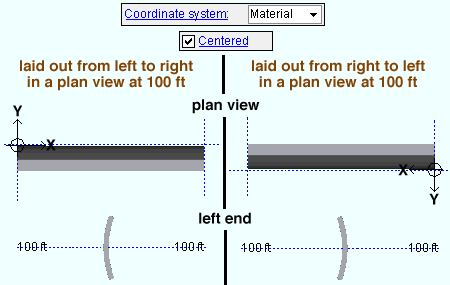 Material Add Rolled Plate ( Modeling )
Material Add Rolled Plate ( Modeling )
Tool summary :
Also see :
- Plate Material (topic)
- Miscellaneous members versus legacy miscellaneous members (topic)
- Rolled plate miscellaneous member (instead of legacy)
- Surface template (in the submaterial detail for rolled plate)
- Add Material
- Show legacy miscellaneous members in member add screen (for adding a legacy misc mem using F2 )
page 1 | contents | add material | add legacy misc mem | material window | top
Adding a rolled plate material or legacy miscellaneous member :
1 . Rolled plate can be added to the 3D model as a submaterial of a member or as a legacy miscellaneous member. In either case, locating work points should be done in a view whose work plane is orthogonal to (at right angles to) the material or legacy miscellaneous member being added. Do one (1) of the following:
To add a rolled plate TO a member (pre-selection method):
To add a rolled plate AS a legacy miscellaneous member:
Confirm that the box is checked for User and Site Options > Site > "
Show legacy miscellaneous members in member add screen ." Then, in Modeling , press F2 > filter for "
Miscellaneous steel " > select " Miscellaneous -- Rolled Plate " > continue to step 2.
2 . The status line prompts, " Add: ... ." Locate- Pan -Return mouse bindings become active.
|
|
|
bindings |
2a : Select the appropriate Locate option, then left-click ( Locate ) at two different points to define the work line (and X material axis ) of the rolled plate to be between those two points. The first work point located establishes the material reference point (the pivot point around which subsequent rotation takes place). The following illustration shows that laying out the rolled plate from left to right cause the plate to be brought in with no Z-axis rotation.
3 . The Rolled Plate Material window opens. On it are settings for the rolled plate you are adding.
3a : The " Included angle " and " Outside radius " define the rolled plate's " Unrolled width ." Be sure to also define the " Material thickness ."
3b : Press the " OK " button at the bottom of the window to close the window.
4 . The Rotate Material window opens, and a preview of the to-be-added rolled plate is shown on screen. Do one (1) of the following:
Alternative 1 : Press " Cancel " to back up to step 2 . This stops the rolled plate from being added.
Alternative 2 : To accept the material's present rotation, press the " OK " button.
Alternative 3 : Change the material's rotational settings and then press " OK " if you want to rotate the material around various axes that originate at the first work point that you located in step 2.
5 : Different end steps are required depending on whether you are adding a material to a member or adding a stand-alone legacy miscellaneous member.
End steps for adding a material TO a member: After rotating the material into place > right-click ( Return ) if done adding material to the member > Change All Options can be applied if the member the material is being added to is batched together with other members with the same mark.
End steps for adding a material AS a legacy miscellaneous member: After rotating the legacy miscellaneous member into place > right-click ( Return ) when you are done.
Tip 1: If you added a legacy miscellaneous member (see step 1), you cannot re-open the Rolled Plate Material window using Edit Member -- that opens the [Legacy] Miscellaneous Member Edit window. Rolled Plate Material is a material window, not a member window, and you therefore have to open it by, for example, using Edit One Material , " Edit Other " on the context menu, or by double-clicking the material in the Model Tree .
Tip 2: If you added this material as a submaterial (see step 1), you can, in addition to the edit methods described in tip 1, double-click the material to re-open the Rolled Plate Material window.
page 1 | contents | add material | add legacy misc mem | material window | top
